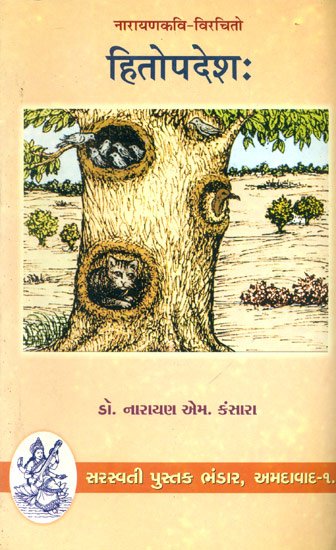Hitopadesha [sanskrit]
8,857 words
The Sanskrit edition of the Hitopadesha referencing the English translation and grammatical analysis. Written by Narayana in the 8th century, the Hitopadesha represents a collection of short stories involving human and animal characters, instructing the reader on basic ancient Indian moral values and ethical conduct. Alternative titles: हितोपदेशः, Hitopadeśa, Hitopadesa.
Verse 4.11
उपायं चिन्तयेत् प्राज्ञो ह्य् अपायम् अपि चिन्तयेत् ।
पश्यतो बक-मूर्खस्य नकुलैर् भक्षिताः सुताः ॥ ११ ॥
upāyaṃ cintayet prājño hy apāyam api cintayet |
paśyato baka-mūrkhasya nakulair bhakṣitāḥ sutāḥ || 11 ||
The English translation of Hitopadesha Verse 4.11 is contained in the book The Hitopadesa of Sri Narayana Pandita by Satya Narayana dasa. This book is not available online so in order to read the full text and translation you should buy the book:
Buy now! English translation by Satya Narayana dasa (1997)
Glossary of Sanskrit terms
Note: This extracts Sanskrit terms and links to English definitions from the glossary, based on an experimental segmentation of verse (4.11). Some terms could be superfluous while some might not be mentioned. Click on the word to show English definitions.
Upaya, Apaya, Api, Pashyat, Pashyata, Baka, Murkha, Nakula, Bhakshita, Suta,
Analysis of Sanskrit grammar
Note: this is an experimental feature and only shows the first possible analysis of the Sanskrit text (Hitopadesha Verse 4.11). If the system was successful in segmenting the sentence, you will see of which words it is made up of, generally consisting of Nouns, Pronouns, Verbs, Participles and Indeclinables. Click on the link to show all possible derivations of the word.
- Line 1: “upāyaṃ cintayet prājño hy apāyam api cintayet ”
- upāyam -
-
upāya (noun, masculine)[adverb], [accusative single]upāyā (noun, feminine)[adverb]
- cintayet -
-
√cint (verb class 10)[optative active third single]
- prājño* -
-
- Cannot analyse hy*ap
- apāyam -
-
apāya (noun, masculine)[adverb], [accusative single]√pāy (verb class 1)[imperfect active first single]√pai (verb class 1)[imperfect active first single]
- api -
-
api (indeclinable preposition)[indeclinable preposition]ap (noun, neuter)[locative single]api (Preverb)[Preverb]
- cintayet -
-
√cint (verb class 10)[optative active third single]
- Line 2: “paśyato baka-mūrkhasya nakulair bhakṣitāḥ sutāḥ ”
- paśyato* -
-
paśyat (noun, masculine)[accusative plural], [ablative single], [genitive single]paśyat (noun, neuter)[ablative single], [genitive single]paśyata (noun, masculine)[nominative single]
- baka -
-
baka (noun, masculine)[compound], [vocative single]
- mūrkhasya -
-
mūrkha (noun, masculine)[genitive single]mūrkha (noun, neuter)[genitive single]
- nakulair -
-
nakula (noun, masculine)[instrumental plural]nakula (noun, neuter)[instrumental plural]
- bhakṣitāḥ -
-
bhakṣita (noun, masculine)[nominative plural], [vocative plural]bhakṣitā (noun, feminine)[nominative plural], [vocative plural], [accusative plural]√bhakṣ -> bhakṣita (participle, masculine)[nominative plural from √bhakṣ], [vocative plural from √bhakṣ]√bhakṣ -> bhakṣitā (participle, feminine)[nominative plural from √bhakṣ], [vocative plural from √bhakṣ], [accusative plural from √bhakṣ]
- sutāḥ -
-
suta (noun, masculine)[nominative plural], [vocative plural]sutā (noun, feminine)[nominative plural], [vocative plural], [accusative plural]√su -> suta (participle, masculine)[nominative plural from √su class 5 verb], [vocative plural from √su class 5 verb]√su -> sutā (participle, feminine)[nominative plural from √su class 5 verb], [vocative plural from √su class 5 verb], [accusative plural from √su class 5 verb]√sū -> suta (participle, masculine)[nominative plural from √sū class 6 verb], [vocative plural from √sū class 6 verb]√sū -> sutā (participle, feminine)[nominative plural from √sū class 6 verb], [vocative plural from √sū class 6 verb], [accusative plural from √sū class 6 verb]√sū -> suta (participle, masculine)[nominative plural from √sū class 2 verb], [vocative plural from √sū class 2 verb]√sū -> sutā (participle, feminine)[nominative plural from √sū class 2 verb], [vocative plural from √sū class 2 verb], [accusative plural from √sū class 2 verb]
Other editions:
Also see the following editions of the Sanskrit text or (alternative) English translations of the Hitopadesha Verse 4.11
The Hitopadesa of Narayana
by M. R. Kale (2015)
Edited with A Sanskrit Commentary "Marma-Prakasika" and Notes in English; 9788120806023; Published by Motilal Banarsidass Publishers Pvt. Ltd.
Buy now!
Hitopadesa (in Gujarati)
by Dr. Narayan M. Kansara (2007)
[હિતોપદેશ]—[ડો. નારાયણ એમ. કંસારા] Sanskrit Text With Gujarati Translation; Published by Saraswati Pustak Bhandar, Ahmedabad
Buy now!Preview of verse 4.11 in Gujarati sript:
ઉપાયં ચિન્તયેત્ પ્રાજ્ઞો હ્ય્ અપાયમ્ અપિ ચિન્તયેત્ ।
પશ્યતો બક-મૂર્ખસ્ય નકુલૈર્ ભક્ષિતાઃ સુતાઃ ॥ ૧૧ ॥
![Hitopadesha [sanskrit] - book cover](/uploads/a/Hitopadesha.jpg)

